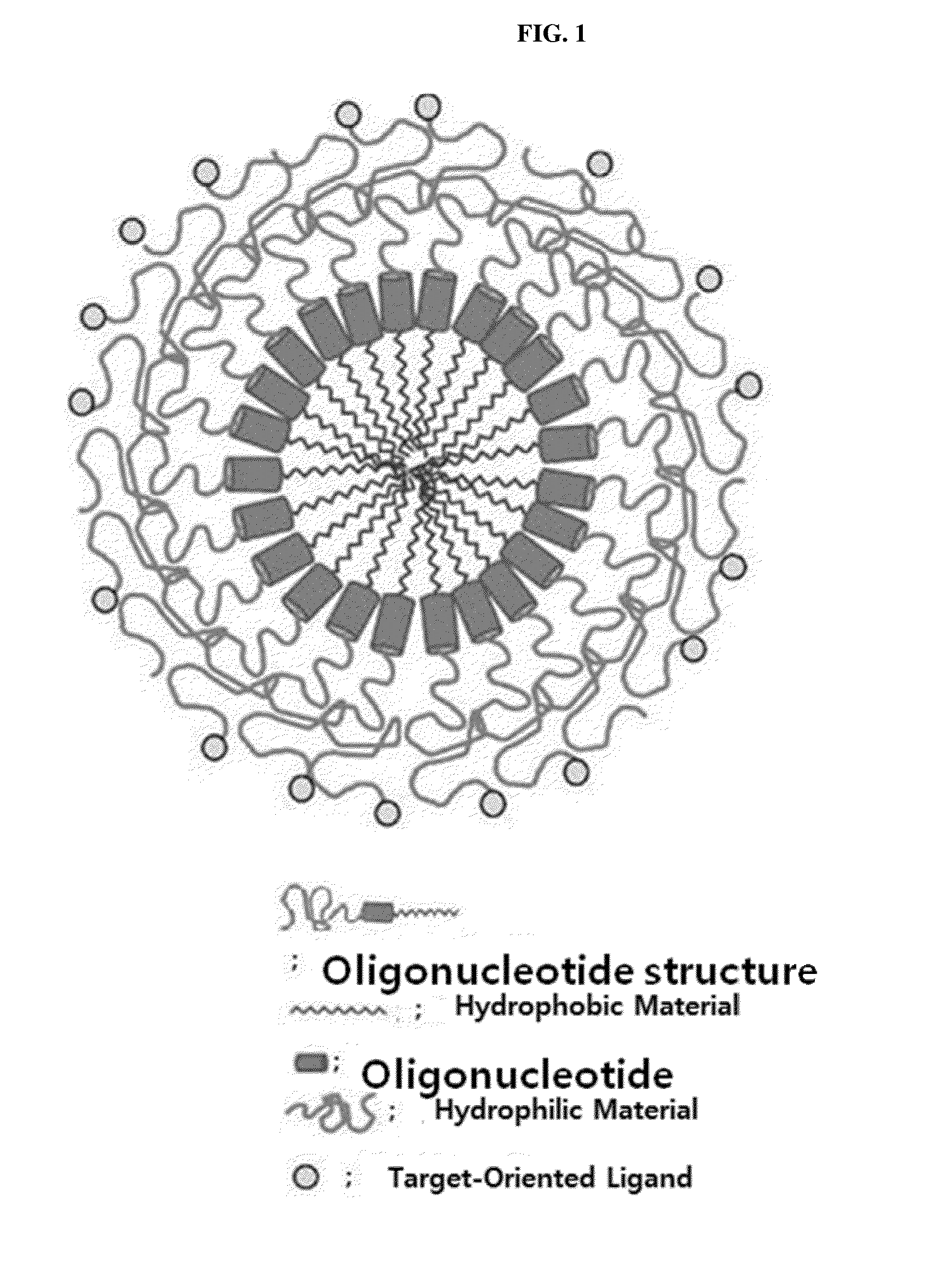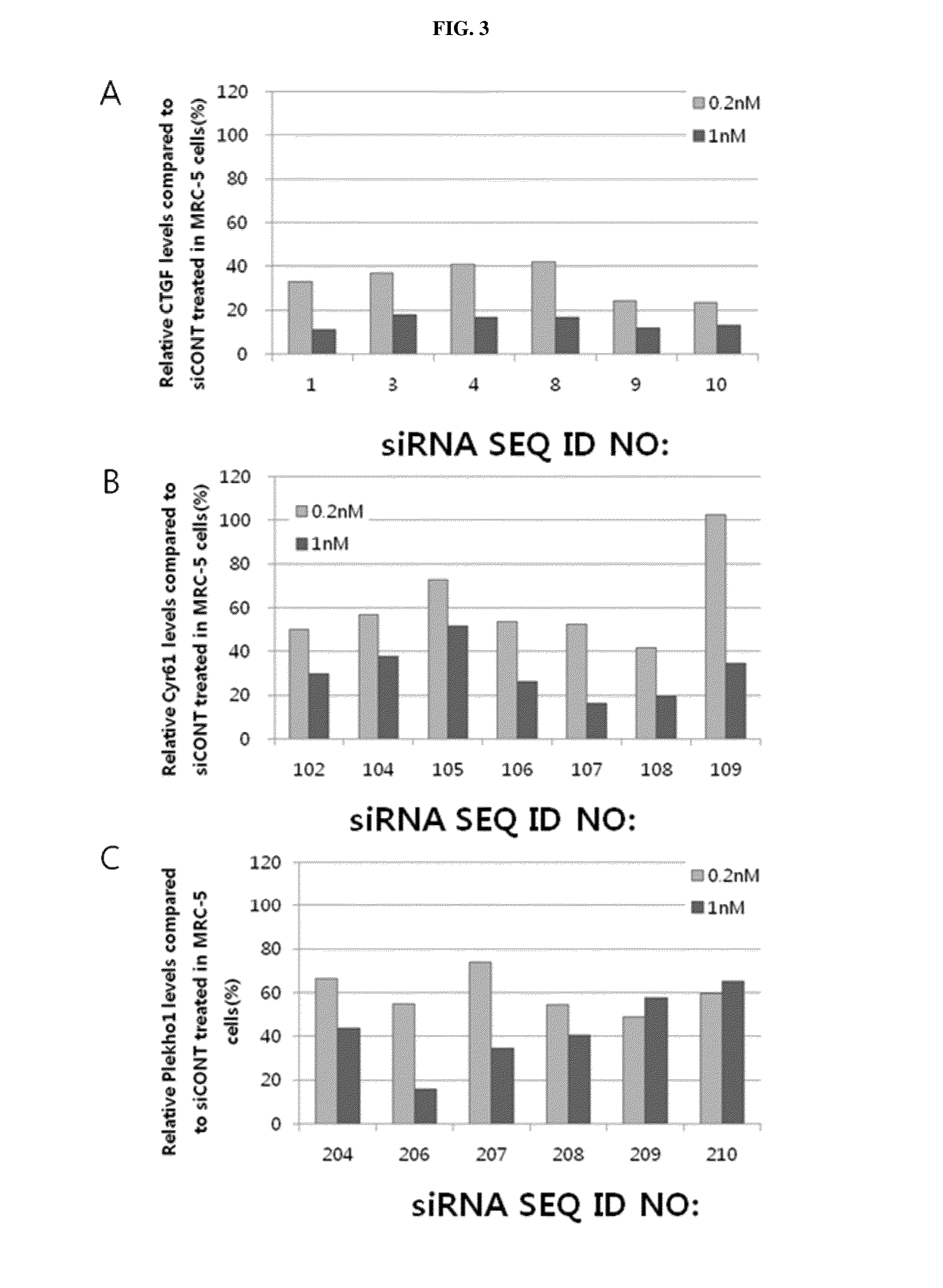Respiratory disease-related gene specific sirna, double-helical oligo RNA structure containing sirna, compositon containing same for preventing or treating respiratory disease
a technology of respiratory disease and sirna, which is applied in the direction of antibacterial agents, drug compositions, immunological disorders, etc., can solve the problems of difficult to confirm whether or not the combination is easily performed, low stability in vivo, and difficulty in confirming the effect of combination
- Summary
- Abstract
- Description
- Claims
- Application Information
AI Technical Summary
Benefits of technology
Problems solved by technology
Method used
Image
Examples
example 1
Design of Target Sequence of CTGF, Cyr61 or Plekho1 and Production of siRNA
[0175]604 types of target sequences (sense strands) capable of being bonded to mRNA sequence of CTGF (Homo sapiens) gene (NM_001901), mRNA sequence of Cyr61 (Homo sapiens) gene (NM_001554), mRNA sequence of Plekho1 (Homo sapiens) gene (NM_016274), mRNA sequence of CTGF (Mus musculus) gene (NM_010217), mRNA sequence of Cyr61 (Mus musculus) gene (NM_010516), or mRNA sequence of Plekho1 (Mus musculus) gene (NM_023320) were designed, and siRNAs of antisense strands having complementary sequences to the target sequences were produced.
[0176]First, a gene design program (Turbo si-Designer) developed by Bioneer Co., was used to design target sequence that the siRNA is capable of being bonded from mRNA sequences of the corresponding genes. The siRNA for respiratory disease-related genes according to the present invention has a double stranded structure including a sense strand consisting of 19 nucleotides and an antis...
example 2
Production of Double-Helical Oligo RNA Structure (PEG-SAMiRNA)
[0177]The double-helical oligo RNA structure (PEG-SAMiRNA) produced in the present invention has a structure represented by the following Structural Formula (16):
C24-5′-S-3′-PEG
AS Structural Formula 16
[0178]In Structural Formula (16), S is a sense strand of siRNA; AS is an antisense strand of siRNA; PEG is a hydrophilic material, that is, polyethylene glycol; C24 is a hydrophobic material and tetradocosane including a disulfide bond; and 5′ and 3′ mean directions of the double-helical oligo RNA end.
[0179]The sense strand of siRNA of Structural Formula (16) was produced by synthesizing a double-helical oligo RNA-hydrophilic material structure of a sense strand in which polyethylene glycol is bonded to 3′ end by the above-described method in which phosphodiester bonds forming an RNA backbone structure are linked by using J-cyanoethyl phosphoramidite, based on 3′ polyethylene glycol (PEG, Mn=2,000)-CPG produced by Example 1...
example 3
Production of Improved Double-Helical Oligo RNA Structure (Mono-HEG-SAMiRNA)
[0182]The improved double-helical oligo RNA structure produced in the present invention is obtained by using [PO3−-hexaethylene glycol]4 (hereinafter, referred to as ‘Mono-HEG-SAMiRNA’, see Structural Formula (17)) which is the hydrophilic material block instead of using PEG which is the hydrophilic material, and has the following Structure Formula (17):
C24-5-S-3′-[(Hexa Ethylene Glycol)-PO3−]4
AS Structure Formula 17
[0183]In Structural Formula (17), S is a sense strand of siRNA; AS is an antisense strand of siRNA; [Hexa Ethylene Glycol]4 is a hydrophilic material monomer; C24 is a hydrophobic material and tetradocosane including a disulfide bond; and 5 ′ and 3′ mean directions of the double-helical oligo RNA sense strand end.
[0184]The structure of Mono-HEG SAMiRNA according to Structural Formula (17) may be represented by the following Structural Formula (18):
[0185]RNA of the reaction product was separated...
PUM
| Property | Measurement | Unit |
|---|---|---|
| median survival time | aaaaa | aaaaa |
| structure | aaaaa | aaaaa |
| hydrophilic | aaaaa | aaaaa |
Abstract
Description
Claims
Application Information
 Login to View More
Login to View More - R&D
- Intellectual Property
- Life Sciences
- Materials
- Tech Scout
- Unparalleled Data Quality
- Higher Quality Content
- 60% Fewer Hallucinations
Browse by: Latest US Patents, China's latest patents, Technical Efficacy Thesaurus, Application Domain, Technology Topic, Popular Technical Reports.
© 2025 PatSnap. All rights reserved.Legal|Privacy policy|Modern Slavery Act Transparency Statement|Sitemap|About US| Contact US: help@patsnap.com



